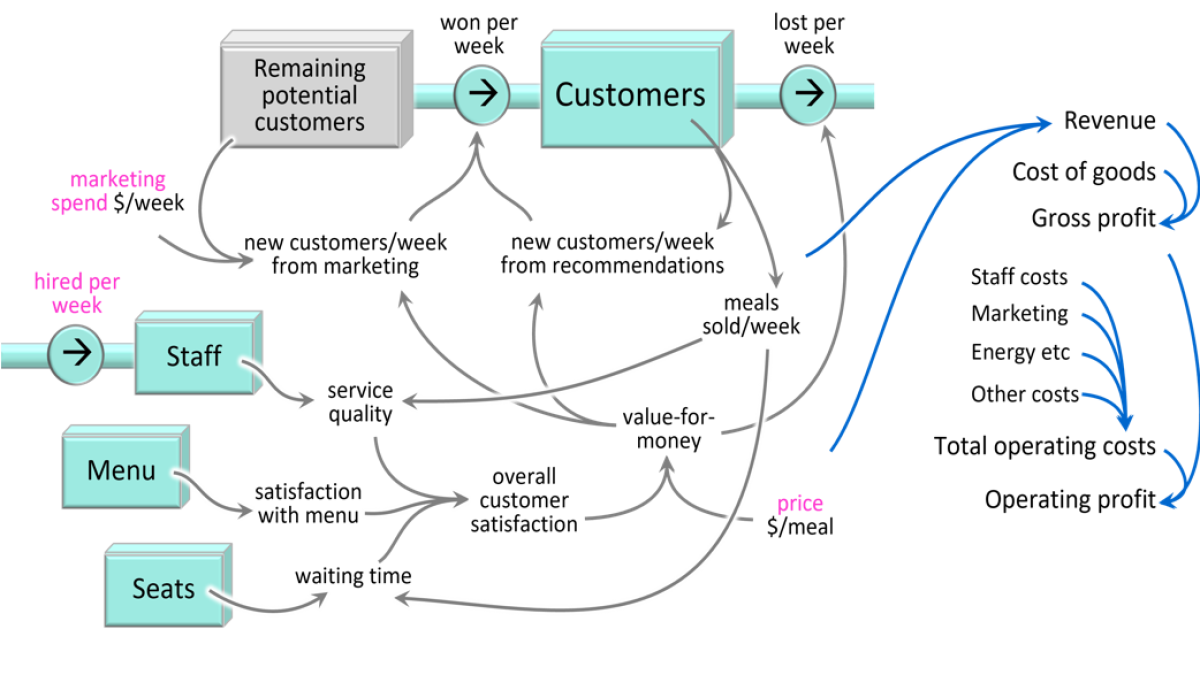18 Standard business system structures save time and cut errors

How all business and performance issues conform with standard models - so no need to start from scratch when building digital-twin business models
I will soon get on to explain why our models truly are "digital twins". But the existence of standard, reliable structures and models is part of that case - so let's look at that first.
Some small causal structures work reliably in many cases to capture how things change.
How can common structures arise? I explained in Why theory matters! that our digital twin business models reflect a rigorous 4-part theory of how business systems work. Following that theory gives us a reliable 4-step process to build a digital twin business model.
For example, many of us want to know why revenue has been rising or falling as it has been doing, and what levers we have to improve revenue growth. Follow the process to answer that question for a consumable product or service (durable products and one-time services are a bit different) and we get:
- revenue per period = sales * price
- sales = customers * sales per customer
- customers (today) = customers (one period ago) plus customers won minus customers lost
... giving us this structure:

Check out this model here. The model-project at that link includes an example of the model applied to sales and revenue for a retail store.
We would go on to ask what further factors cause each of the items above to change, such as our marketing spend, sales effort, service quality, competitors’ price and so on.
There are many standard structures – but not too many! For example:
- how service quality reflects the balance between customer demand for service and your capacity to deliver it
- how the "quality" of a customer-base (the average revenue they generate) changes over time
- how customers and sales are won and lost between you and competitors
- how quality and reputation drive changes to customer numbers and sales
A relatively limited library of such standard structures is enough to get you started on most common challenges or initiatives you want to tackle.
Complete standard business models
"But my business is unique!" Sorry – but no it isn’t.
Following the 4-step process further, until we have covered the whole of a business system, also ends up finding common structures that apply to any specific business of a certain type. For example, every local table-service restaurant in the world has:
- a menu (its product range)
- staff (to prepare and serve the food)
- tables (its capacity)
- customers, who use the restaurant with some frequency
Our online course Dynamic Business Modeling Essentials takes you through every step of how to build that model - showing you at the same time how the standard 4-step modeling process works.
Get the Dynamic Business Modeling Essentials course here
.. and get ⅓ off the full price by using coupon blog33 at checkout.
Of course, the numbers – and how they are changing – vary hugely between individual cases. And the exact relationships between the elements will vary, for example customers’ sensitivity to service or value. But those elements and relationships themselves are common. You do achieve some level of service quality, and that does affect how your customers feel about continuing to use your restaurant.
Then, we can modify such a common model for any additions (e.g. adding take-out service) or variations (a town-centre or highway unit relying on passing traffic instead of a local population).
Similarly, every airline, law firm, construction company etc. will conform with one of a few variations on standard business system structures for their sector.
Save time and be more reliable The benefits we get from the existence of such standard structures and business models are huge.
Clearly, it takes less time and effort to simply configure an already-working model to reflect a specific case than to build that model from scratch.
And because you know the model already works, you will make fewer mistakes!
But – be careful! – there may always be unique features of any case that mean you have to make adjustments. So always ask "Is this exactly how it works in my case"
Categories: : business models
 Kim Warren
Kim Warren 